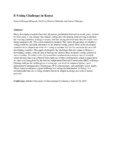| dc.description.abstract | Many developing countries have had disastrous presidential elections in recent years. In most of these cases, it was alleged that manual voting and vote-tallying took too long to produce the winning candidate, leading to anxiety and fear among the electorate that the results were being tampered with. This often resulted in mayhem. This raises the question on whether e-voting could be a possible alternative to the manual voting system. Most of the developed countries have adopted one form of e-voting or another, but this has not been the case with developing countries. This paper investigates the challenges that are unique to Kenya, a developing country, with the aim of finding out whether there an ideal e-voting system for such a country. To achieve this, the researchers conducted an extensive survey research where primary data was collected from eight out of nine constituencies where e-registration of voters was being done by the Interim Independent Electoral Commission (IIEC) of Kenya. Findings indicate the challenges to e-voting are: low level of computer literacy, poor Information Communication Technology (ICT) infrastructure, and unreliable power supply. These issues would pose a great challenge to e-voting implementation in Kenya. It is recommended that the e-voting solution should be simple in design and solar or battery powered. | en_US |

